|
|
|
Sort Order |
|
|
|
Items / Page
|
|
|
|
|
|
|
| Srl | Item |
| 1 |
ID:
188930
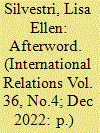

|
|
|
|
|
| Summary/Abstract |
How should we think about war today? This afterword assesses the impact of using a temporal lens to understand contemporary conflict. Reflecting upon my own work on media and war alongside wider societal relationships to violence, I consider the ways in which new technologies and styles of warfighting change both our view of time and our understanding of war itself. In particular, I show how a shift from space to time helps focus attention on the personal and lived experience of US war, on the importance of routines both in constituting and obscuring wartime, on how many issues of contemporary war have become a matter of digitized perspective, and finally how emergent technologies have unsettled familiar temporal patterns of conflict. War today is media-drenched but struggles to occupy our attention over sustained periods. It remains an epochal political force that we tend to approach through deeply individualized, microcosmic stories. It proceeds at breakneck pace but rarely gets anywhere. These questions and tensions underline the importance of focusing not only on the resolutely temporal aspects of wartime, but also on the way in which shifts in time are changing the very nature and politics of war in the 21st century.
|
|
|
|
|
|
|
|
|
|
|
|
|
|
|
|
| 2 |
ID:
096477
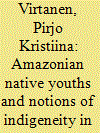

|
|
|
|
|
| Publication |
2010.
|
| Summary/Abstract |
The indigenous presence in urban areas of Amazonia has become more visible as Indian populations have negotiated their own spaces and acted in new contexts previously reserved for the dominant society. This article looks at ways in which today's young Indians in an urban area define and interpret their new cultural and social situations, drawing from research conducted with Apurin , Cashinahua and Manchineri youths in Rio Branco, a city in Acre state, Western Brazil. These young people occupy a variety of "native" and "non-native" habituses and develop their notions of indigeneity within complex social networks as part of their strategy for rupturing the otherness associated with indigeneity. The text contributes to the discussion on the theory of practice and identity politics, as well as embodiment. Young Indians in urban Amazonia constitute their agencies in multiple ways and use various embodiments based in the practices and knowledge of their native groups and those of urban national and global society. The young natives break with the image of Lowland South American Indians as peoples uncontaminated by urban influences and help promote new interactions between native populations in the reserve and the city.
|
|
|
|
|
|
|
|
|
|
|
|
|
|
|
|
| 3 |
ID:
189030
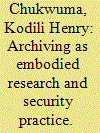

|
|
|
|
|
| Summary/Abstract |
This article explores the importance of embodiment in (research on) archival practices on state counter-terrorism policy in Nigeria. In doing so, the article seeks to contribute to the ongoing discussion around methodology and methods in critical security studies and other related fields in international relations by focusing on (researchers’) bodies as sites of knowledge production and intervention. Building on three empirical themes of fragmentation, labelling and gatekeeping that emerged from fieldwork in Abuja, Nigeria, I demonstrate how embodiment operates in active research contexts in the production – and problematization – of in/security. To do this, I draw inspiration from ideas around state archival practice; embodiment in critical security studies, especially as discussed in feminist and postcolonial work; and in/security theory to scaffold my broader methodological approach. A focus on embodiment, the article argues, marks the researcher’s body – and research – as integral to the development of theories and findings about security. At the same time, exploring the ways in which the (researcher’s) body is (re)produced in relation to identity and subjectivity encourages greater reflexivity in our research practice and fieldwork, as we are continually reminded that our work and our words are grounded in the standpoints that we occupy. The article concludes by identifying some useful strategies from my fieldwork for grappling with the challenges and tensions that emerge from bodily encounters in (security) research process.
|
|
|
|
|
|
|
|
|
|
|
|
|
|
|
|
| 4 |
ID:
162412
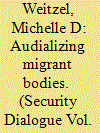

|
|
|
|
|
| Summary/Abstract |
Sound represents a salient yet rarely examined counterpoint to visuality and materiality in security, international bordering, and mobility literature. Using the context of sub-Saharan African migration as grounding for empirical analysis and drawing on fieldwork conducted in Morocco in 2015 and 2016, this article lays the foundation for a research agenda that understands voice, and the sonic body more broadly, as mechanisms of political power. In examining the central roles that sound, hearing, and voice play in strategies of individual resistance at border crossings, as well as in state, private, and transnational communication and surveillance regimes, it attends to the ways in which sound and the audialized body reconfigure power relations, and structure mobility and personal identity. This analysis contributes to the growing literature addressing biometric borders and the deterritorialization of security practices, and argues that sound, along with more familiar nodes of securitization, constitutes a critical site of governmentality and therefore of ethical and moral negotiation.
|
|
|
|
|
|
|
|
|
|
|
|
|
|
|
|
| 5 |
ID:
111532
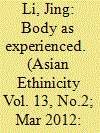

|
|
|
|
|
| Publication |
2012.
|
| Summary/Abstract |
This article looks at the filming of the Dai river bathing custom by the media professionals for tourism promotion in Xishuang Banna, China. It speaks to the previous scholarships that have studied the Otherness of ethnic minorities in China's mainstream and popular representations. Yet this case contextualizes this issue in the era of China's domestic tourism, when ethnic cultures and bodies are increasingly put on display, experienced, and (re-)produced through individualized, immediate, embodied encounters in tourist zones. By taking embodied experiences to the center, this article studies the touristic representation of ethnic minorities as China's national Others from an angle of embodiment. It inquires how the embodied experiences of both media professionals and Dai bathers at the filming constitute the very process during which Otherness, difference, and selfness are perceived, actualized, and (re-)produced in localized reality and at the grassroots level.
|
|
|
|
|
|
|
|
|
|
|
|
|
|
|
|
| 6 |
ID:
197402


|
|
|
|
|
| Summary/Abstract |
Peace processes require societies to break with animosity and violence. Scholars and practitioners have traditionally focused on institutional and structural mechanisms. Recent contributions have stressed the need to address the emotional legacies of destructive conflicts and how they influence peace processes. We build on these contributions by engaging current debates on decolonisation. We advance a three-part argument that places decolonising emotion at the core of peace and conflict studies. First, prevailing concepts and practices of peace rely on collective emotions that are western and colonial in origin. Emotions are central to the power dynamics that sustain colonial legacies and the practices of exclusion and injustice that ensue from them. Second, decolonising emotion requires an openness to different feelings which, in turn, can open up possibilities for creative ways of thinking about and practising peace. Third, these realms – colonial legacies and resistant ways of being and feeling – do not exist in isolation. Potentials for peace-making emerge from complex ‘interfaces’ between them, which we examine through two cases: the emotion of Han (한/恨) in Korean traditions of conflict resolution; and links between mourning and conflict management in the Maluilgal First Nation of the Torres Strait in far northern Australia.
|
|
|
|
|
|
|
|
|
|
|
|
|
|
|
|
| 7 |
ID:
123921
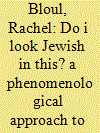

|
|
|
|
|
| Publication |
2013.
|
| Summary/Abstract |
Racialised interactions inform the corporeal memory of both racists and their victims. This translates in bodily styles which reproduce alienated intercorporeal exchanges. The racial abjection of the victims is embedded at the somatic level in a racialised corporeal schema which obtains even when victims are not a priori visibly different to an external observer. The damaging intercorporeal dynamics of racialised abjection resist critical deconstruction. This explains the unwitting reproduction of racism even by those who consciously repudiate it and the difficulties of explaining to non-victims the enduring - and damaging- effects of those crucial moments when 'the glance of the other brings about a break in embodiment'.
|
|
|
|
|
|
|
|
|
|
|
|
|
|
|
|
| 8 |
ID:
123589
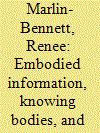

|
|
|
|
|
| Publication |
2013.
|
| Summary/Abstract |
The turn to materialism emerging in world politics scholarship promises fruitful ways of understanding power and political life by focusing on agency in the physical world. Yet immaterial information and 'the virtual' seem to dominate our lives. How can we understand the relationship between the material and the informational? Does this understanding promise any further insight into agency, power, and world politics? The focus in this paper is on the materiality (corporeality) and information of the human body as a special case. Embodied information is the information contained in the body that can potentially be accessed by others through an act of power. The way in which embodied knowledge is implicated in practices of world politics is exemplified by surveillance, DNA databases, and organ trade. Bodies are also the means by which information becomes sensible: we understand information from various sources and with various kinds of content through our bodies' ability to sense. This knowing body is also implicated in power, as exemplified by the use of sound and the augmentation of the senses through technology. Drawing on the interpretation of embodied information and knowing bodies, this article provides a pragmatic model of world politics in which to control how information flows, how it is extracted from the body, how it is inserted or received, how quickly, and to what end, is to have power or to be powerful.
|
|
|
|
|
|
|
|
|
|
|
|
|
|
|
|
| 9 |
ID:
180055
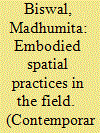

|
|
|
|
|
| Summary/Abstract |
Postmodern anthropology has used the claims of reflexivity, inter-subjectivity and recognition of differences in individual experiences in its attempt to unsettle the authority of traditional anthropology. This has led anthropologists to assert that ethnography is a cultural construct, whereby ‘fieldwork’ is conceptualised as ‘embodied spatial practice’. Drawing on village studies from India, this paper argues that the recognition of different embodied practices of ethnographers from diverse social locations has not necessarily led to the democratisation of the discipline. Conversely, insufficient engagement with hierarchical, overlapping power relations within the ethnographic field, as well as within the disciplinary establishment, has led to the standardisation of disciplinary articulations of research ethics, the terms of which privilege hegemonic groups within the discipline. The articulation of the concerns of scholars from marginalised social groups often remains difficult within such disciplinary frameworks. This paper argues that establishing a critical tradition in ethnography in the true sense requires the postmodern sensibility of recognition of the differences in experiences, supplemented with feminist and subaltern critical interrogations of power and knowledge.
|
|
|
|
|
|
|
|
|
|
|
|
|
|
|
|
| 10 |
ID:
151189
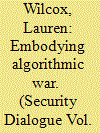

|
|
|
|
|
| Summary/Abstract |
Through a discussion of drone warfare, and in particular the massacre of 23 people in the Uruzgan province in Afghanistan in 2010, I argue that drone warfare is both embodied and embodying. Drawing from posthuman feminist theorists such as Donna Haraway and N Katherine Hayles, I understand the turn toward data and machine intelligence not as an other-than-human process of decisionmaking that deprives humans of sovereignty, but as a form of embodiment that reworks and undermines essentialist notions of culture and nature, biology and technology. Through the intermediation of algorithmic, visual, and affective modes of embodiment, drone warfare reproduces gendered and racialized bodies that enable a necropolitics of massacre. Finally, the category of gender demonstrates a flaw in the supposed perfectibility of the algorithm in removing issues of identity or prejudice from security practices, as well as the perceptions of drone assemblages as comprising sublime technologies of perfect analysis and vision. Gender as both a mode of embodiment and a category of analysis is not removed by algorithmic war, but rather is put into the service of the violence it enables.
|
|
|
|
|
|
|
|
|
|
|
|
|
|
|
|
| 11 |
ID:
188184
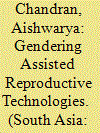

|
|
|
|
|
| Summary/Abstract |
Literature on commercial surrogacy argues that assisted reproduction technologies (ARTs) problematise presumed essentialist dichotomies of nature and culture. While technologies of commercial surrogacy naturalise the medicalisation of the body, these technologies in turn also produce new knowledge about the biological facts of the body. In what ways are knowledge about reproductive labour and women’s reproductive capacities embedded in these technologies? How do these technologies invite us to imagine maternal bodies? Under regimes of stratified reproduction that inflect reproductive bodies with caste, class and racial politics, how do we read the production of the gendered body within commercial gestational surrogacy practices? The paper draws on ethnographic research conducted in Mumbai to study how technologies of commercial surrogacy interact with the normative idioms of conception. I will attempt to show how assumptions about gendered bodies and gendered roles are embedded within the material teleologies of these technologies, which in turn produce newer material-semiotic significations of the reproductive body.
|
|
|
|
|
|
|
|
|
|
|
|
|
|
|
|
| 12 |
ID:
197405


|
|
|
|
|
| Summary/Abstract |
What happens if international interveners feel emotions that they consider unsanctioned, unwanted and unprofessional? What if they enact and manage their emotions in ways that they – or others – deem unacceptable? If international interveners face anxiety about being ‘too emotional’ or not feeling or expressing the ‘right’ emotions, does this challenge their sense of identity? And what consequences could this have for peacebuilding and the conflict-affected population in which they were working? Building on the growing body of critical peace and conflict scholarship that has analysed international interveners at the micro-scale, this article analyses how individual interveners’ emotional and embodied experiences influence their understanding and practice of peacebuilding. Based on a discourse analysis of the memoirs of 10 international interveners, this article identifies two primary interpretive repertoires that the interveners employed and argues that they generated two ideal-type subject positions: the intervener as objective, rational, technocratic ‘expert’ and the intervener as irrational, fallible, vulnerable ‘human’. These subject positions determined the feeling rules that the interveners followed and the dilemmas they faced. This, in turn, affected how the interveners perceived the conflict-affected societies in which they were working, and how they understood and practised peacebuilding.
|
|
|
|
|
|
|
|
|
|
|
|
|
|
|
|
| 13 |
ID:
144690
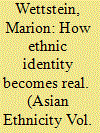

|
|
|
|
|
| Summary/Abstract |
Taking the material and performative world of the Nagas in Northeast India by way of example, this paper examines how identity, above all ‘ethnic’ identity, is manifested and gets incorporated into the understanding that people have of themselves. Following the shifts in identity over time by comparing ritual performances at the turn of the last century with present-day festivals in Nagaland, it is argued that the enactment of identity roles in public performative events provides a mechanism that makes identity concepts such as ‘ethnic identity’ real to people. The liminoid state during the performance enables individuals to live through identity roles emotionally, mentally, and somatically. It is suggested that the enactment of identity roles in public performances can thus be taken as a key to explain why and how identities can shift over time and between contexts.
|
|
|
|
|
|
|
|
|
|
|
|
|
|
|
|
| 14 |
ID:
167653
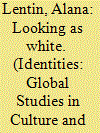

|
|
|
|
|
| Summary/Abstract |
Smartphone apps for anti-racism education and intervention are being developed by organisations in various countries. The ubiquity of smartphone use and app methodology, as Grant argues, have the potential to disrupt racial knowledges and facilitate anti-racist action. I use Nicholas Mirzoeff’s ‘zones of appearance and non-appearance’ and Derek Hook’s discussion of ‘racialising embodiment’ to discuss the potential of one such app, Everyday Racism, to challenge and disrupt white supremacy. The Australian-based app uses gamification to encourage users to participate in ‘bystander anti-racism’. However, by failing to question the neutrality of the default white bystander, the app risks reproducing hegemonic constellations of white agency versus racialized inaction. I argue that, in the zone of appearance, it is not enough to make racism apparent. It is necessary to appear. To appear first requires exposing nonappearance including the role even of the well-intentioned in maintaining it
|
|
|
|
|
|
|
|
|
|
|
|
|
|
|
|
| 15 |
ID:
168187
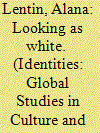

|
|
|
|
|
| Summary/Abstract |
Smartphone apps for anti-racism education and intervention are being developed by organisations in various countries. The ubiquity of smartphone use and app methodology, as Grant argues, have the potential to disrupt racial knowledges and facilitate anti-racist action. I use Nicholas Mirzoeff’s ‘zones of appearance and non-appearance’ and Derek Hook’s discussion of ‘racialising embodiment’ to discuss the potential of one such app, Everyday Racism, to challenge and disrupt white supremacy. The Australian-based app uses gamification to encourage users to participate in ‘bystander anti-racism’. However, by failing to question the neutrality of the default white bystander, the app risks reproducing hegemonic constellations of white agency versus racialized inaction. I argue that, in the zone of appearance, it is not enough to make racism apparent. It is necessary to appear. To appear first requires exposing nonappearance including the role even of the well-intentioned in maintaining it.
|
|
|
|
|
|
|
|
|
|
|
|
|
|
|
|
| 16 |
ID:
155745
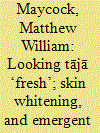

|
|
|
|
|
| Summary/Abstract |
Throughout the Indian subcontinent there is a broad range of skin-whitening products (SWPs) widely advertised on TV, cinema on the streets etc … . In recent years, the multinational companies who produce these products have begun to focus on an untapped market – men and boys. Complementing feminist insights relating to the ways in which ‘body work’ is a form of control over women and constitutes a means of maintaining gender hierarchies, this paper considers the implications for men of a specific manifestation of ‘body work’, in this instance the use of SWPs. Based on the analysis of the ways that a group of young Nepali men talked about these products, this paper considers the evolving use of the Nepali word tājā (adj; fresh). Ultimately, this paper considers what are the consequences of the consumption of SWPs for local manifestations of embodied masculinities in far-west Nepal.
|
|
|
|
|
|
|
|
|
|
|
|
|
|
|
|
| 17 |
ID:
141469
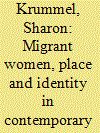

|
|
|
|
|
| Summary/Abstract |
While recent scholarship on migration has reflected growing attention to gender and to the intersectionality of race, gender and sexuality, there has been little focus on women’s emotional and bodily responses to migration in the context of larger structures of sexism, racism and the legacies of colonialism. In this paper, I examine some literary portrayals of how migrant women’s relationships with specific places of origin and settlement, both steeped in structural relationships of unequal power and experienced on an immediate, psychological and bodily plane, are fundamental to migrant women’s changing sense of belonging and identity. Jamaica Kincaid in her novel Lucy, Tsitsi Dangarembga in her novel Nervous Conditions and Dionne Brand in the opening poems of her volume No Language is Neutral evoke some of the complex ways in which migration can affect women’s lives and identities, thus both complementing and critiquing some contemporary theorisations of migration and migrant identities.
|
|
|
|
|
|
|
|
|
|
|
|
|
|
|
|
| 18 |
ID:
114017
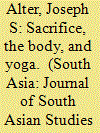

|
|
|
|
|
| Publication |
2012.
|
| Summary/Abstract |
In most general terms, hathayoga involves the internalisation and embodied literalisation of the Vedic fire sacrifice. Reflecting on the place of sacrifice in anthropological theory, and on the way in which sacrifice structures the relationship between humans and gods in terms of gift obligations, this paper explores the theoretical implications of hathayoga's embodied literalisation of a profoundly symbolic act. Although similar to various forms of ascetic renunciation, hathayoga is unique, it will be argued, in being structured as the physiological antithesis of religious ritual. Self-realisation based on the internalised yajna sacrifice undermines the binary structure of the sacred and the profane and makes god irrelevant. This raises theoretical questions concerning the social significance of a ritual that is anti-social on a number of different levels.
|
|
|
|
|
|
|
|
|
|
|
|
|
|
|
|
| 19 |
ID:
112366
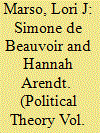

|
|
|
|
|
| Publication |
2012.
|
| Summary/Abstract |
This article compares Hannah Arendt's famous essay on Adolf Eichmann's trial in Israel in 1961 to Simone de Beauvoir's little studied piece, "An Eye for an Eye," on the trial of Robert Brasillach in France in 1945. Arendt and Beauvoir each determine the complicity of individuals acting within a political order that seeks to eliminate certain forms of otherness and difference, but come to differing conclusions about the significance of the crimes. I explain Beauvoir's account of ambiguity, on which she draws in her judgment of Brasillach and elaborates in her 1948 Ethics of Ambiguity, and measure it against Arendt's account of Eichmann's thoughtlessness and its effects on the destruction of conditions of worldly plurality. Linking the failure of ethical judgment on the part of individuals to prior systemic political conditions, Beauvoir helps us recognize struggles over the meaning of bodies and conditions of inequality as central to politics.
|
|
|
|
|
|
|
|
|
|
|
|
|
|
|
|
| 20 |
ID:
195145


|
|
|
|
|
| Summary/Abstract |
This article explores how bodily living and experiencing life as colonized subjects affects the perception of space and time. It argues that the Zionist settler-colonial trinity of control (checkpoints, ID cards, and permits) are not mere physical barriers of separation or restriction of movement and mobility. They are also a direct mechanism of colonial power that articulates how oppressive spaces are lived and consequently form the colonized perception of being-in-the-world. Based on two years of ethnographic study at Qalandia checkpoint between 2015 and 2017, the article adopts a phenomenological anthropological lens and focuses on two moments of bodily experiences related to passing the checkpoint: First, the bodily experience before reaching the checkpoint; and second, the bodily experience when crossing the checkpoint.
|
|
|
|
|
|
|
|
|
|
|
|
|
|
|
|
|
|
|
|
|